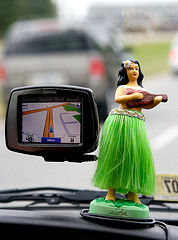

I recently spent a long time in the car, driving cross country. I had a GPS that led me from across the USA, including through New York City, at 60-80 miles an hour. It was easy and convenient to focus on the road and the radio while listening to the dulcet tones of the GPS, but I missed the map reading and location awareness I’d had in previous cross country trips, when using a Rand McNally atlas. Because all I’d been doing was following directions, I didn’t have the understanding of the larger context–how roads fit together, what cool places were just off the interstate, or even which city I stopped in for lunch.
In the vein of Mark Suster’s “Is it Time to Learn or Earn” (which is definitely worth a read), I wanted to talk about whether your current task is a “mapping” task or a “GPS” task, and what each type of task looks like.
Mapping tasks can be high level or low level, but share the following characteristics. They:
- require you to look at the big picture
- are focused on a long term goal, not tactics
- often result in serendipitous results
- take longer
- sometimes require backtracking from dead ends
- make you stop every so often and look around
- have learning as a direct goal
- require iterative search queries
Examples of some of my past mapping tasks include selecting a public records data vendor, hiring an employee, creating my first REST API, and making my first departmental budget. Don’t be afraid to ask for help with mapping tasks, or to stop every so often and make sure you on right track.
GPS tasks, on the other hand, tend to be tactical. GPS tasks:
- often have clear directions (sometimes from others, sometimes from your experience)
- don’t require you to understand context
- require little, if any, exploration
- are action oriented
- often are smaller in scope
- have learning as a by-product, if at all
- can be phrased as a single google query
- may not be core to your business or job
Some of my past GPS tasks include: setting up a virtual server for development, finding a way to display release changes in maven, connecting to the QuickBooks Online API and writing an employee review (after the first one).
The main difference between these tasks is the amount of context needed. With mapping tasks, you have to have your head up and be “looking around” at the problem landscape. With GPS tasks, you can put your head down and just “drive” toward task completion.
If you do a GPS task often enough, you’ll start to acquire context, just as if you drive with a GPS around a new city for a few days, you start to see how the streets and areas fit together. The first time you do something relatively complex, like setting up a new server, hiring or making a department budget, it will be a mapping task–but after a few times it may turn into a GPS task (especially if you document your process).
Next time you take on a task at work, think about whether it is a complex, big picture task that would be best handled by mapping, or a quick, “gotta get this done” task that you don’t need to fully understand.
